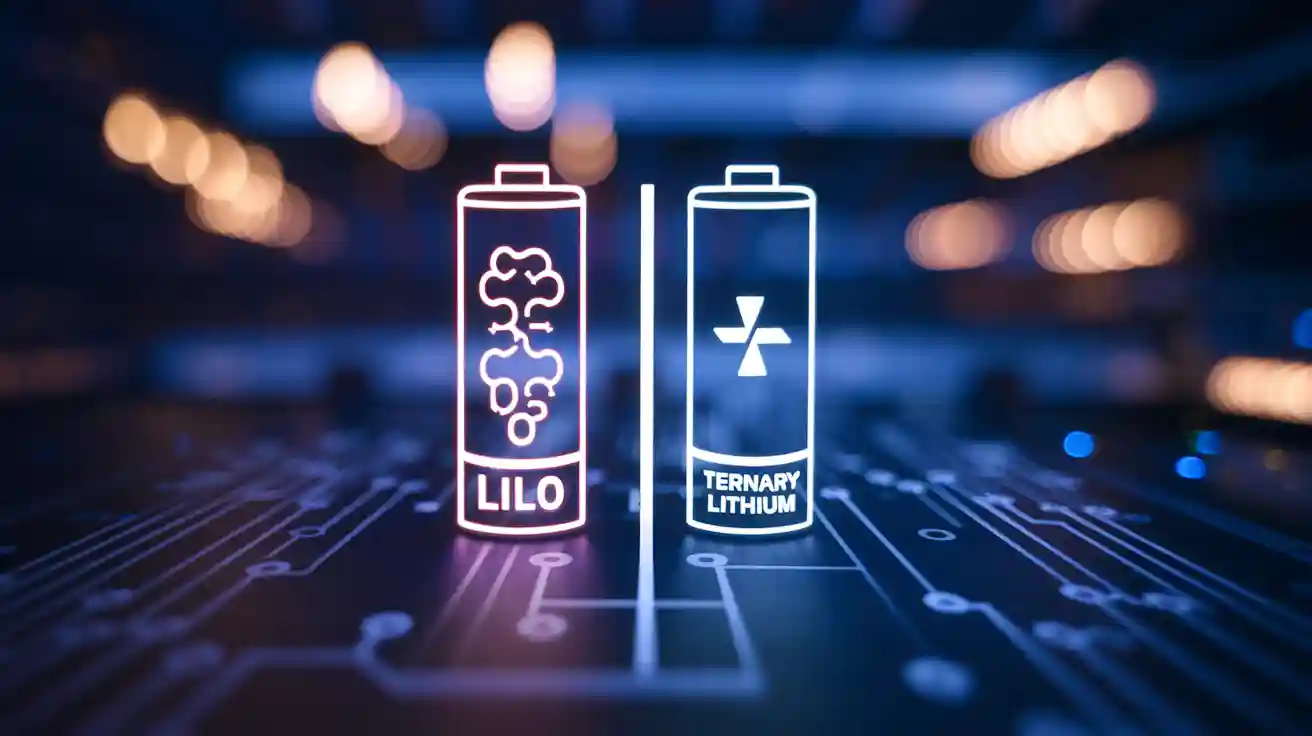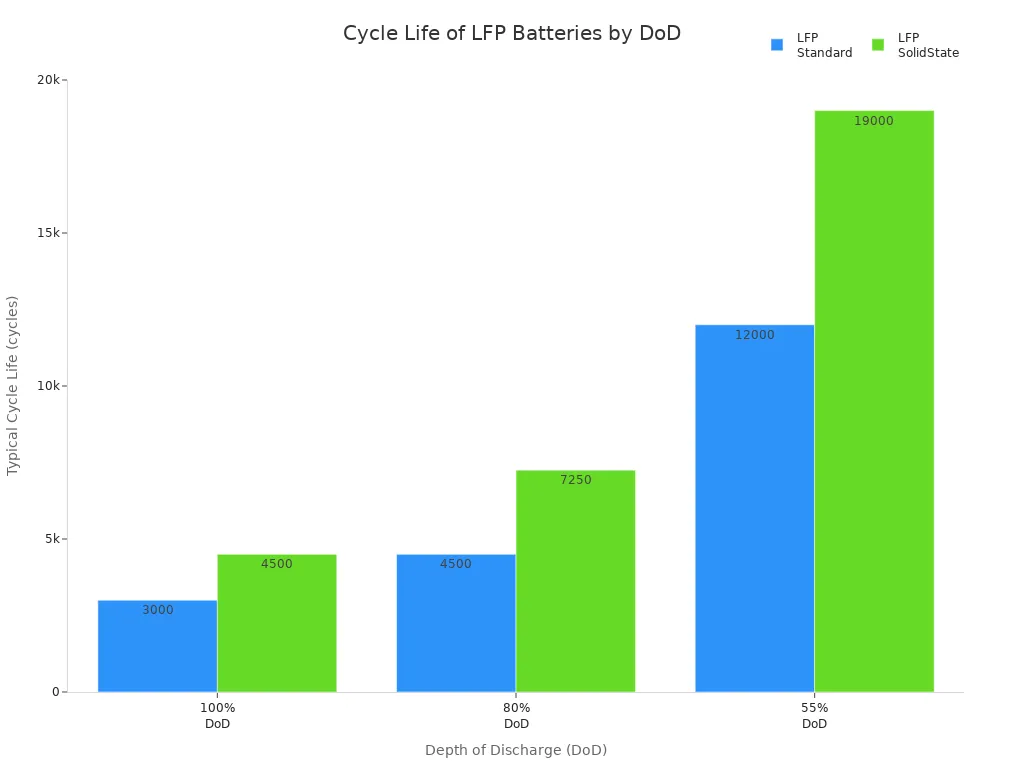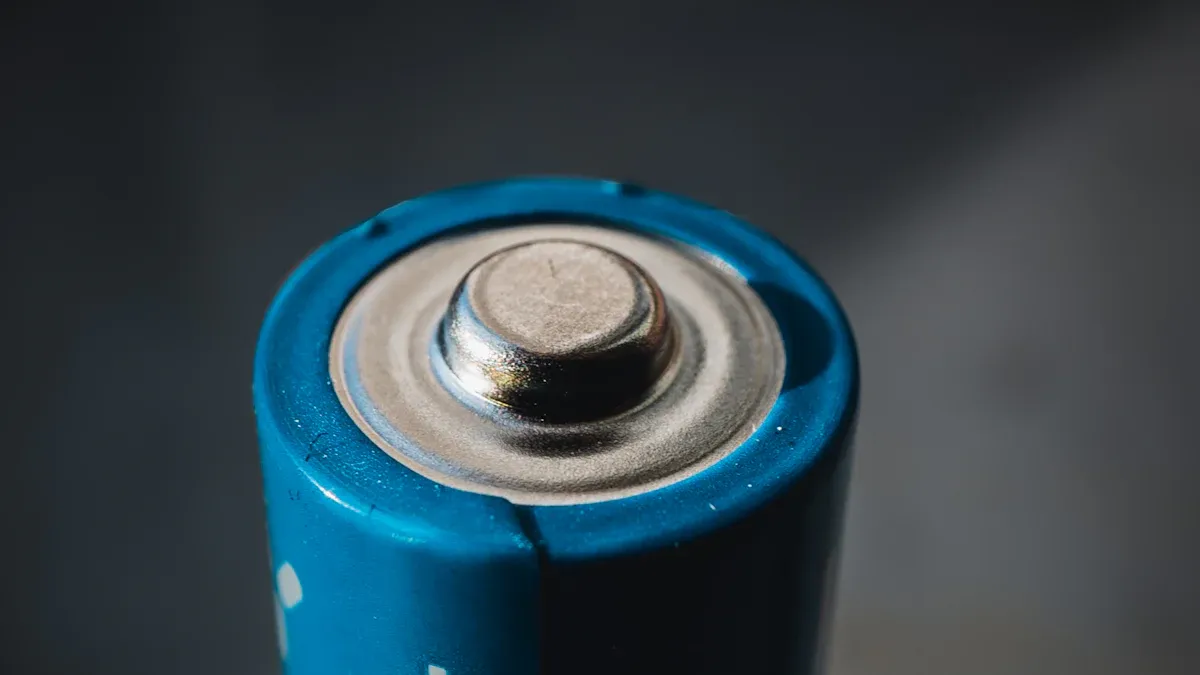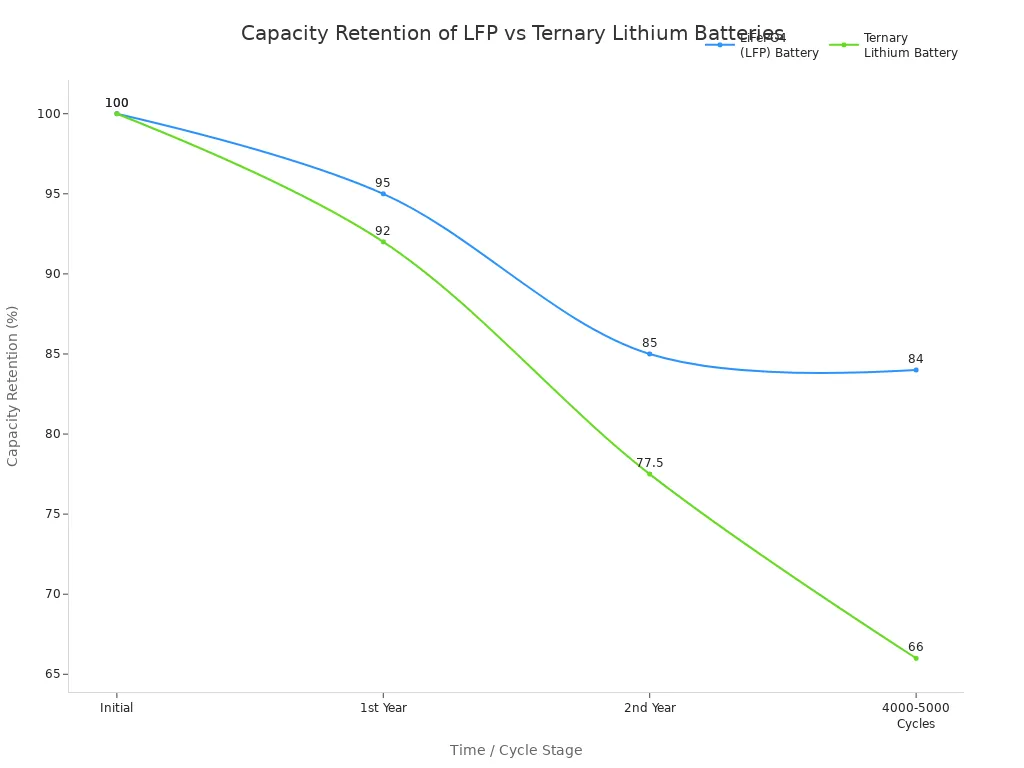
LiLO battery technology offers strong safety and long lifespan, making it a popular choice for energy storage and EV use. Ternary lithium batteries provide higher energy density and faster charging, which improves performance in portable devices. Safety matters most when choosing a battery, especially for EVs and home systems. Lithium batteries differ in cost, cycle life, and how they handle heat. Understanding these differences helps users pick the right battery for their needs.
Safety and performance can change how a battery works in real-world situations.
LiLO Battery Technology
What Is LiLO (LFP) Battery
LiLO battery technology refers to the lithium iron phosphate battery, often called LFP battery. This battery uses lithium iron phosphate as its cathode material. The LFP battery features an olivine crystal structure, which creates a stable and strong bond between atoms. This structure allows the battery to operate with a flat voltage profile and low risk of overheating. The LFP battery stands out for its high safety and long cycle life. The chemical composition of the LFP battery prevents oxygen loss, which helps avoid fires and explosions. Manufacturers use high-purity lithium salts and control particle size to keep the structure stable and improve performance.
Key Features
LFP battery technology offers several important features:
- High safety: The LFP battery resists thermal runaway and does not release oxygen during failure. Abuse tests show that the LFP battery can handle nail penetration, overcharging, and crushing without catching fire.
- Long cycle life: Good quality LFP batteries last over 5,000 cycles, with some reaching up to 12,000 cycles at lower depths of discharge. This means the battery can be charged and discharged many times before losing capacity.
- Cost-effectiveness: The LFP battery uses cheaper raw materials than other lithium batteries, making it more affordable.
- Stable performance: The LFP battery maintains its capacity over time and works well in different temperatures.

Common Uses
LFP battery technology appears in many applications. Home energy storage systems use the LFP battery because of its high safety, long cycle life, and low cost. The LFP battery also powers electric vehicles, buses, and RVs. Many people choose the LFP battery for solar energy storage and backup power. The lithium iron phosphate battery works well in places where safety and durability matter most.
Ternary Lithium Battery
What Is Ternary Lithium
A ternary lithium battery uses a mix of three metals in its cathode: nickel, cobalt, and manganese or aluminum. The most common types are NMC (nickel manganese cobalt oxide) and NCA (nickel cobalt aluminum oxide). These batteries differ from lithium iron phosphate batteries because they use nickel and cobalt, which help increase energy and power. The table below shows the main chemical differences between ternary lithium batteries and LFP batteries:
| Battery Type | Main Cathode Components | Key Characteristics |
|---|---|---|
| Ternary Lithium Batteries (NMC, NCA) | Lithium nickel manganese cobalt oxides (NMC), lithium nickel cobalt aluminum oxides (NCA) | Contain cobalt and nickel, provide higher power and specific energy (~200-250 Wh/kg), but have lower thermal stability and potential safety concerns |
| LFP Batteries | Lithium iron phosphate | Offer longer cycle life, better thermal stability, lower specific energy (~120 Wh/kg), and improved safety |
Key Features
Ternary lithium batteries stand out for their high energy density and fast charging speed. The battery can store more energy in a smaller space, which makes it lighter and more compact. This high energy density allows electric vehicles to travel longer distances without stopping for charging. The battery also supports fast charging, so users spend less time waiting. Nickel-rich cathodes, like NCM 811, give the battery even more capacity, but they can lower safety and cycle life. New battery designs and better battery management systems help improve safety and performance. Manufacturers work on new electrolytes and coatings to make the battery last longer and charge faster. The battery market grows quickly as more people want electric vehicles and better energy storage.
Ternary lithium batteries reach energy densities up to 232Wh/kg, with some advanced models going even higher. Their charging speed and power output make them a top choice for high-performance needs.
Common Uses
Ternary lithium batteries power many electric vehicles because they offer long driving ranges and quick charging. Car makers choose this battery to help drivers travel farther and spend less time at charging stations. The battery also appears in consumer electronics like smartphones, laptops, and tablets. These devices need a battery that is small, light, and lasts a long time between charges. The battery’s high charging speed and energy density make it ideal for these uses. Industrial machines and backup power systems also use ternary lithium batteries for their strong performance and fast charging. The battery’s ability to deliver power quickly and recharge at high speed supports many modern technologies.
Battery Comparison

Energy Density
Energy density measures how much energy a battery can store for its weight. Ternary lithium batteries lead in this area. They reach average energy densities between 150 and 200 Wh/kg. Some advanced models, like the 18650 cylindrical type, can go up to 232 Wh/kg. Future projections show even higher values. In contrast, the LFP battery usually offers 100 to 150 Wh/kg. This means ternary lithium batteries store more energy in a smaller, lighter package. The table below shows the typical energy density values:
| Battery Type | Average Energy Density (Wh/kg) | Specific Example (18650 Cylindrical) | Future Projection (Wh/kg) |
|---|---|---|---|
| LiFePO4 (LFP) | 100 – 150 | N/A | N/A |
| Ternary Lithium Battery | 150 – 200 | 232 | 293 |
Ternary lithium batteries suit applications where weight and size matter, such as electric vehicles and portable electronics. The LFP battery works well for stationary energy storage, where high safety and long cycle life are more important than compact size.
Safety
Safety remains a top concern for any battery. The LFP battery stands out for its high safety. It resists thermal runaway and can tolerate temperatures between 350°C and 500°C without breaking down. Abuse tests, such as nail penetration and overcharging, show that LFP batteries rarely catch fire. They have a very low temperature rise rate, about 1.5°C per minute, making dangerous events unlikely. Real-world tests confirm that LFP batteries behave safely even in car accidents.
Ternary lithium batteries, while offering higher energy density, face more safety issues. They start to decompose below 300°C and can release oxygen, which increases fire risk. In abuse tests, ternary lithium batteries show a much higher temperature rise, up to 200°C per minute. This can lead to internal combustion and ignition. Both battery types need a good Battery Management System, but LFP chemistry provides a safer profile by design.
LFP batteries provide high safety and rarely cause fires, while ternary lithium batteries need extra care to avoid safety issues.
Cycle Life
Cycle life tells how many times a battery can charge and discharge before losing much capacity. The LFP battery offers a long cycle life, often lasting 3,500 to 5,000 cycles at 1C to 80% capacity. Some LFP batteries keep about 84% of their capacity after 4,000 to 5,000 cycles. Ternary lithium batteries usually last about 2,500 cycles, with capacity dropping to 66% after the same number of cycles. The LFP battery degrades more slowly, keeping its performance over time. Ternary lithium batteries lose capacity faster, especially in the first two years.

The long cycle life of the LFP battery makes it a strong choice for energy storage and vehicles that need to last many years.
Cost
Cost plays a big role in battery selection. The LFP battery costs less than ternary lithium batteries. In 2024, LFP cells cost below $60 per kWh, with some as low as $44 per kWh for large-scale orders. Ternary lithium battery cells cost about $65 to $68 per kWh. Pack prices also show LFP batteries as more affordable, especially in China, where prices can be as low as $94 per kWh. Ternary lithium batteries cost more because they use rare metals like nickel and cobalt. These metals have volatile prices, which can make ternary lithium batteries even more expensive.
| Battery Type | Cost per kWh (Cell) | Cost per kWh (Pack) | Notes |
|---|---|---|---|
| LFP (LiFePO4) | Around $55 (as low as $44) | Average pack price $115 (China ~$94) | Lower cost, stable raw materials |
| NMC (Ternary Lithium) | $65-$68 | Included in average pack price $115 | Higher cost, price sensitive to nickel/cobalt |
LFP batteries use iron and phosphate, which are cheap and easy to find. Ternary lithium batteries depend on nickel and cobalt, which are expensive and less stable in price. This makes the LFP battery a better choice for users who want to save money and avoid price swings.
Charging Speed
Charging speed affects how quickly a battery can fill up. Ternary lithium batteries offer faster charging speed than LFP batteries. They can handle high currents and recharge quickly, which helps electric vehicles and devices get back to work sooner. The LFP battery charges at a slower speed. It cannot accept as much current without risking damage or shortening its cycle life. This slower charging speed makes the LFP battery less suitable for users who need quick turnarounds.
Ternary lithium batteries deliver faster charging speed, while the LFP battery focuses on high safety and long cycle life.
Environmental Impact
Environmental impact depends on raw materials, recycling, and production. The LFP battery uses iron and phosphate, which are abundant and less harmful to the environment. Ternary lithium batteries use nickel and cobalt, which are harder to mine and process. These metals can cause more pollution and have higher social costs. Recycling also differs. Ternary lithium batteries contain valuable metals, so companies recycle them more often. The LFP battery lacks these metals, so recycling rates are lower. Both battery types use mechanical, pyrometallurgical, and hydrometallurgical recycling methods. However, these processes can create toxic waste, especially for ternary lithium batteries.
| Aspect | LFP (LiLO) Batteries | Ternary Lithium Batteries (NCA, NMC) |
|---|---|---|
| Main Recycling Methods | Mechanical, pyrometallurgy, hydrometallurgy | Same methods, different efficiencies |
| Material Recovery Focus | Lacks cobalt/nickel, less economic incentive | Contains valuable metals, higher recycling |
| Environmental Impact | Lower due to abundant materials | Higher due to mining and toxic waste |
Both battery types need better recycling methods to reduce environmental harm. The LFP battery has a smaller environmental footprint due to its materials.
Application Scenarios
Different users have different needs. The LFP battery fits users who want high safety, long cycle life, and low cost. It works best in city electric vehicles, buses, home energy storage, and backup power. Ternary lithium batteries suit users who need high energy density, faster charging speed, and better cold resistance. They power high-performance electric vehicles, smartphones, and laptops. Users with strict performance requirements, such as long driving range or fast charging, choose ternary lithium batteries. Those who value safety and affordability pick the LFP battery.
| User Requirement | LiFePO4 (LFP) Battery Characteristics | Ternary Lithium Battery Characteristics |
|---|---|---|
| Safety | Very stable cathode, minimal risk of overheating or fire | Higher risk of thermal runaway, requires careful management |
| Energy Density | Lower energy density, sufficient for many applications | Higher energy density, enables longer driving range |
| Cost | More affordable due to simpler production and cheaper materials | More expensive due to rare metals and complex manufacturing |
| Cycle Life | Longer cycle life (2,000-3,000 cycles) | Shorter cycle life (500-1,000 cycles) |
| Cold Resistance | Poorer cold resistance | Better cold-weather performance |
| Charging Speed | Slower charging speeds | Faster charging speeds |
| Application Focus | Suitable for safety, longevity, affordability (e.g., city EVs) | Suited for high-performance EVs requiring longer range |
- LFP batteries offer high safety, long cycle life, and lower cost, making them ideal for energy storage and city EVs.
- Ternary lithium batteries provide higher energy density, faster charging speed, and better cold resistance, fitting high-performance EVs and portable electronics.
- Users with limited budgets or safety concerns choose LFP batteries. Those with higher performance requirements select ternary lithium batteries.
Choosing the Right Battery
Decision Guide
Selecting the best battery depends on several important factors. Users should consider safety, cost, battery performance, charging speed, and climate. The table below helps compare key decision points for lfp and ternary lithium batteries:
| Decision Factor | LFP (LiFePO4) Battery | Ternary Lithium Battery (NCM/NCA) |
|---|---|---|
| Cathode Material | Lithium iron phosphate | Lithium nickel cobalt manganese oxide (NCM) or aluminate (NCA) |
| Energy Density | Lower, but enough for many uses | Higher, supports longer driving range |
| Safety | Very stable, low risk of overheating or fire | Higher risk of thermal runaway, needs careful management |
| Cycle Life | Longer (2,000-3,000 cycles) | Shorter (500-1,000 cycles) |
| Cost | More affordable, simpler production | More expensive, uses rare metals |
| Charging Speed | Slower charging speeds | Faster charging speeds |
| Cold Resistance | Less effective in cold conditions | Better performance in cold weather |
| Environmental Impact | Lower, uses more sustainable materials | Higher, due to rare metals |
| Application Scenarios | City/commuter EVs, energy storage, electronics | High-performance EVs, long-distance travel |
Tip: Users who value safety and long life often choose lfp batteries. Those who need higher battery performance and fast charging may prefer ternary lithium batteries.
Pros and Cons Table
Choosing between LiLO (LFP) and ternary lithium batteries depends on what users value most. Each battery type brings unique strengths and weaknesses. The table below highlights the main differences:
| Aspect | LiLO (LFP) Battery | Ternary Lithium Battery |
|---|---|---|
| Cost | Lower cost; uses abundant materials | Higher cost; uses rare metals |
| Cycle Life | Long cycle life; withstands many charge cycles | Shorter cycle life; degrades faster |
| Safety | High safety; stable and less prone to fire | Lower safety; risk of thermal runaway |
| Energy Density | Lower energy density; limits range | Higher energy density; supports longer range |
| Charging Speed | Slower charging speed | Faster charging speed |
| Cold Resistance | Poor cold resistance; loses capacity in cold | Good cold resistance; works well in low temps |
| High-Temp Stability | Good stability; resists overheating | Poor thermal stability; safety risks at high temps |
| Application | Best for city EVs, energy storage, power banks | Best for high-performance EVs, electronics |
Note: LFP batteries offer strong safety and long life, making them ideal for users who want reliability and low cost. Ternary lithium batteries provide more power and faster charging, which suits drivers who need longer range and quick charging.
Key Takeaways for Users
- 🛡️ Safety and Budget: LFP batteries work well for users who want safe, affordable options for city driving or home energy storage.
- ⚡ Performance and Range: Ternary lithium batteries fit users who need longer driving range, fast charging, and better cold-weather performance.
- 🔄 Longevity: LFP batteries last longer, making them a smart choice for those who want fewer replacements.
- 🚗 Application Match: City commuters and budget-focused buyers often choose LFP. High-performance EV owners and tech enthusiasts prefer ternary lithium batteries.
Users should weigh these pros and cons based on their own needs. Balancing cost, safety, performance, and climate helps each person select the best battery for their situation.
LiLO (LFP) and ternary lithium batteries each offer unique strengths. LiLO batteries provide strong safety and long life. Ternary lithium batteries deliver higher energy density and faster charging. Readers can use this information to match the right battery to their needs. They should weigh safety, cost, and performance before making a choice. For more details, explore guides on battery technology and new trends.
FAQ
What makes LFP batteries safer than ternary lithium batteries?
LFP batteries use a stable chemical structure. They resist overheating and rarely catch fire. Ternary lithium batteries can overheat more easily. Battery management systems help both types, but LFP batteries offer better safety by design.
Why do ternary lithium batteries charge faster?
Ternary lithium batteries accept higher currents during charging. Their chemistry allows quick movement of ions. This feature helps electric vehicles and devices recharge in less time. LFP batteries charge slower to protect their long cycle life.
Which battery lasts longer in daily use?
LFP batteries usually last longer. They can handle thousands of charge and discharge cycles. Ternary lithium batteries lose capacity faster. Users who want a battery for many years often choose LFP technology.
Are LFP batteries good for cold weather?
LFP batteries lose capacity in cold temperatures. They may not work as well in winter. Ternary lithium batteries perform better in cold weather. Users in cold climates often prefer ternary lithium batteries for reliable performance.
Which battery costs less to produce?
LFP batteries cost less because they use iron and phosphate. These materials are easy to find and cheap. Ternary lithium batteries use nickel and cobalt, which are rare and expensive. This makes LFP batteries more affordable for many users.

